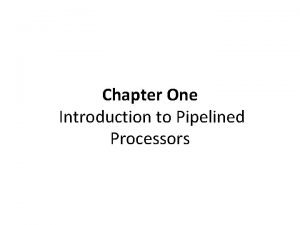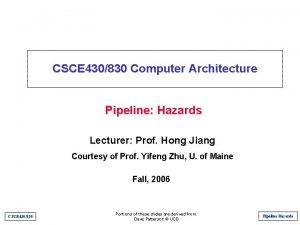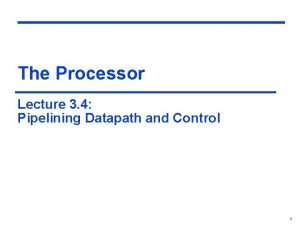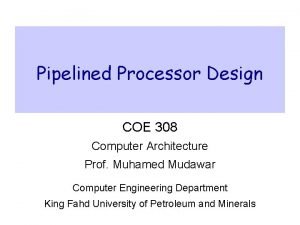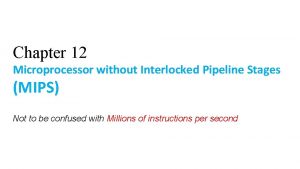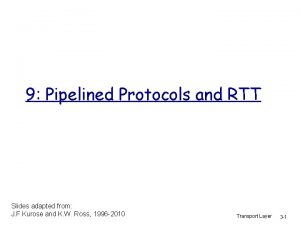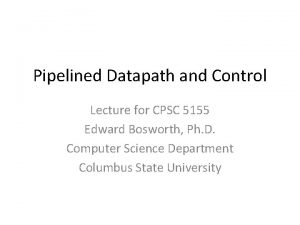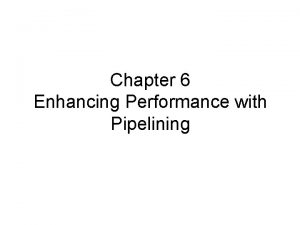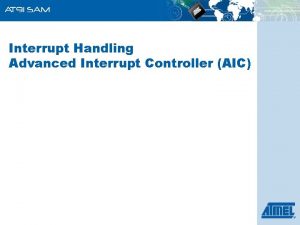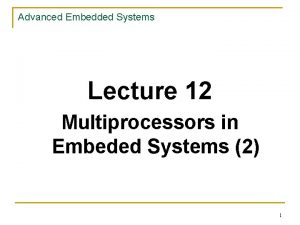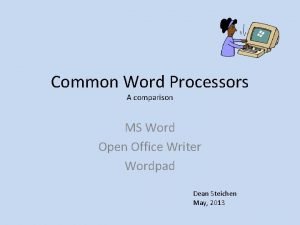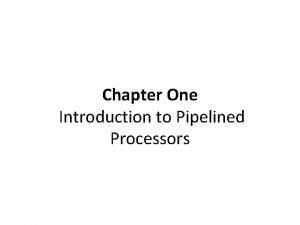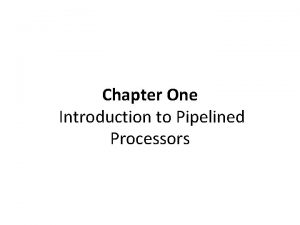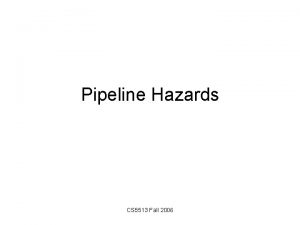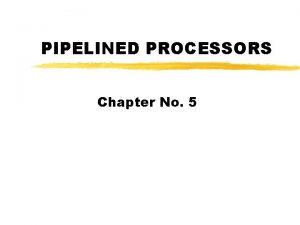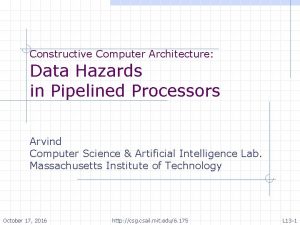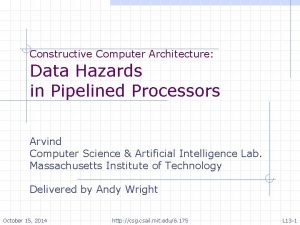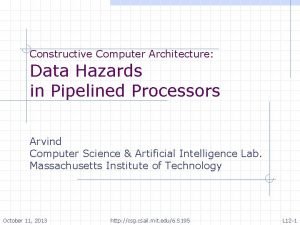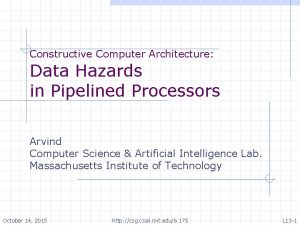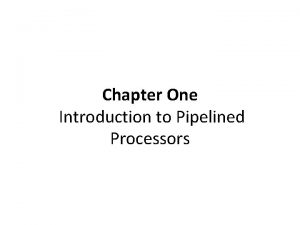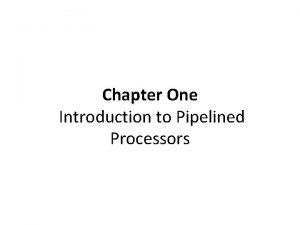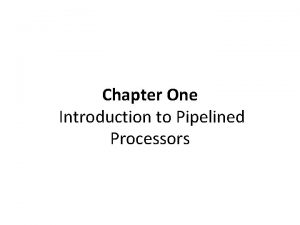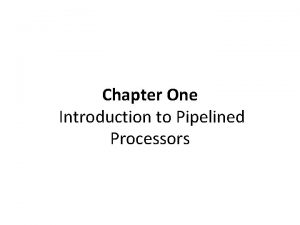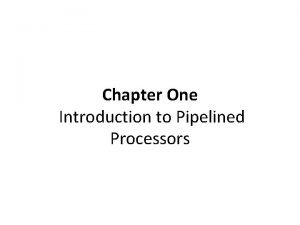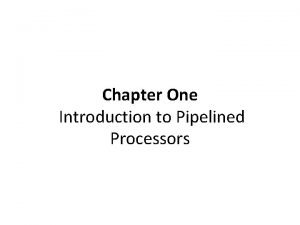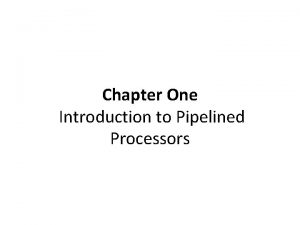Chapter One Introduction to Pipelined Processors Pipeline Hazards

















- Slides: 17

Chapter One Introduction to Pipelined Processors

Pipeline Hazards • A pipeline hazard occurs when the pipeline must stall because some conditions do not permit continued execution. • It is also referred to as a pipeline bubble. • There are three types of hazards: resource, data and control.

Resource Hazard • A resource hazard occurs when two or more instructions in the pipeline need the same resource.


Data Hazards • A data hazard occurs when there is a conflict in the access of an operand location. • Hazards are caused by resource usage conflicts among various instructions • They are triggered by inter-instruction dependencies

Hazard Detection and Resolution Terminologies: • Resource Objects: set of working registers, memory locations and special flags • Data Objects: Content of resource objects • Each Instruction can be considered as a mapping from a set of data objects to a set of data objects.

Hazard Detection and Resolution • Domain D(I) : set of resource of objects whose data objects may affect the execution of instruction I. (e. g. Source Registers) • Range R(I): set of resource objects whose data objects may be modified by the execution of instruction I. (e. g. Destination Register) • Instruction reads from its domain and writes in its range

Hazard Detection and Resolution • Consider execution of instructions I and J, and J appears immediately after I. • There are 3 types of data dependent hazards: 1. RAW (Read After Write) 2. WAW(Write After Write) 3. WAR (Write After Read)

RAW (Read After Write) • The necessary condition for this hazard is

RAW (Read After Write) • Example: I 1 : LOAD r 1, a I 2 : ADD r 2, r 1 • I 2 cannot be correctly executed until r 1 is loaded • Thus I 2 is RAW dependent on I 1

WAW(Write After Write) • The necessary condition is

WAW(Write After Write) • Example I 1 : MUL r 1, r 2 I 2 : ADD r 1, r 4 • Here I 1 and I 2 writes to same destination and hence they are said to be WAW dependent.

WAR(Write After Read) • The necessary condition is

WAR(Write After Read) • • Example: I 1 : MUL r 1, r 2 I 2 : ADD r 2, r 3 Here I 2 has r 2 as destination while I 1 uses it as source and hence they are WAR dependent

Hazard Detection and Resolution • Hazards can be detected in fetch stage by comparing domain and range. • Once detected, there are two methods: 1. Generate a warning signal to prevent hazard 2. Allow incoming instruction through pipe and distribute detection to all pipeline stages.

Control Hazards • Instructions that disrupt the sequential flow of control present problems for pipelines. • The following types of instructions can introduce control hazards: – Unconditional branches. – Conditional branches. – Indirect branches. – Procedure calls. – Procedure returns.

Solutions for Control Hazards • The following are solutions that have been proposed for mitigating control hazards: – Pipeline stall cycles: Freeze the pipeline until the branch outcome and target are known, then proceed with fetch. – Branch delay slots: The compiler must fill these branch delay slots with useful instructions or NOPs – Branch prediction.
 Difference between linear and nonlinear control system ppt
Difference between linear and nonlinear control system ppt Handlers classification in parallel computing
Handlers classification in parallel computing Pipeline hazards
Pipeline hazards Pipeline vs superscalar
Pipeline vs superscalar Pipelined datapath and control in computer architecture
Pipelined datapath and control in computer architecture Pipelined processor design
Pipelined processor design Hyper threading
Hyper threading Pipelined protocol
Pipelined protocol Pipelined datapath
Pipelined datapath Pipelined datapath
Pipelined datapath Programming massively parallel processors
Programming massively parallel processors Interrupt handling in arm processors
Interrupt handling in arm processors History of processors
History of processors Digital camera processors
Digital camera processors Intel processor weakness
Intel processor weakness Embeded processors
Embeded processors Embedded innovator winter 2010
Embedded innovator winter 2010 Comparison of word processors
Comparison of word processors

